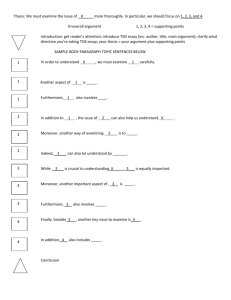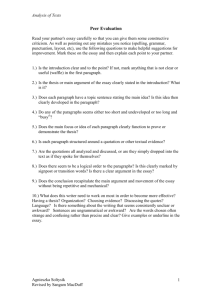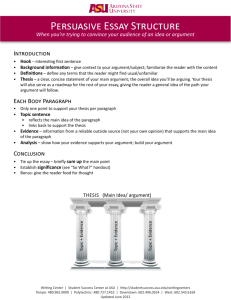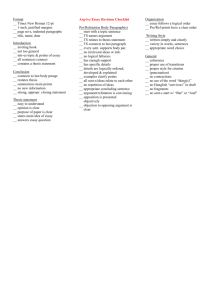Organising and Presenting Your Argument
advertisement
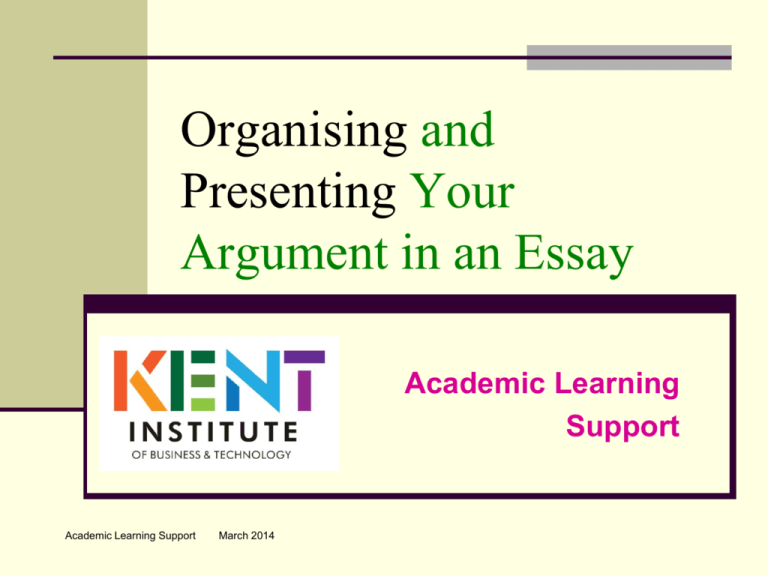
Organising and Presenting Your Argument in an Essay Academic Learning Support Academic Learning Support March 2014 What is an Argument? Taking a position or point of view Supporting that position through: logical reasoning examples research (using academic references) 2 Why is organisation vital to constructing a sound argument? Guides the reader through the stages of your reasoning Enables clear explanation of each point Conveys a sense of the writer’s intellectual credibility 3 More about Argument Every essay needs an argument. Your argument is your opinion or stance (it usually contains an adjective) it is supported and proven throughout your essay. To strengthen your argument consider opposition to your stance: this is called counter argument. 4 Critical Thinking Think about your topic from all angles. What is the current thinking in your field? Do you agree with it? How many possible solutions are there to your essay? The same question can be answered many ways (even with the same references). 5 Presenting your Argument Introduction Thesis statement Body In each paragraph: Main Point (topic sentence/ assertion) Support (evidence) Evaluation Conclusion Reference List Discuss with your partner: In which order should you write the 6 above categories? Introduction – What is it for? The introduction is like a fixed restaurant menu – ‘This is what you are going to get.’ Informs the reader about the topic and purpose Provides a thesis statement Previews main points 7 Thesis Statement – What does it do? The Thesis Statement is the MOST IMPORTANT PART of your paper because it: sets out the claim that your paper will prove; informs the reader of your opinion; guides the reader through your argument. 8 Outline of an essay. Topic: Sydney has many good restaurants. Do you agree/disagree? Intro: Background: Talk generally about food, its role in cities, how food and culture travel. Thesis: Sydney as a city of immigrants has better restaurants than many world cities. 9 Outline of an essay (Introduction continued) In your introduction also introduce points to support thesis: 1.Food accompanies immigration 2. Range of Sydney restaurants. 3. Quality of restaurants. 10 Main Points become body paragraphs Paragraph 1 (About food migrating with people) Paragraph 2 (About the range of restaurants) Paragraph 3 (Quality of Restaurants) ! Paragraphs - not too long. 2 ways to support a point = extra paragraph. 11 Body – What? Why? How? If the Introduction is the menu, the body is the meal. Present your argument in detail using: evidence from reputable sources. support from acknowledged authorities in the field. Rather than BEING your argument, sources SUPPORT your argument! 12 Body Paragraphs and Topic Sentences – what do they do? Body paragraphs expand upon the claims laid out in the introduction Each paragraph deals with one idea Topic sentences introduce the idea 13 Body Paragraphs - Organisation You can organise paragraphs in various ways however usually they follow this pattern: general statement to specific information; most important to less important points; 14 Example of a body paragraph Topic Sentence (an assertion) Jasmines’ is one of the many high quality restaurants in Sydney. Support The food is fresh, unique, authentic and delicious. This sentiment is shared by Helen Greenwood who says of the dishes: ‘complex and elegant and very different to the usual hummus and baba ghanoush at most other Lebanese restaurants’(2008). Evaluation This restaurant is testament to the high quality of Sydney venues and is regularly given positive reviews. 15 Counter argument What is an argument against your thesis? How could you respond? To do so is counter argument. This makes your thesis even stronger. (Opposition to your thesis) Jasmines’ food is too simple. How could you argue against that? It is the simplicity that makes Jasmines’ food authentic and unique. 16 Using research to further your argument Research material from reputable sources can: strengthen your argument; help to disprove counter-arguments. Research material must support the claims made in your topic sentences. Some reputable sources are: Papers in specialist academic journals Books by acknowledged experts in the field Articles in dedicated trade journals University and government websites Databases Less reputable sources include: Wikipedia (authorship cannot be verified) .Com Websites (often aim to promote or sell) 17 Conclusion – Wrapping it up The conclusion sums up the main argument. Summarise the main points Paraphrase the thesis statement Provide concluding statements or implications: What should happen now? Who should do it? No new points 18 Editing and proofreading Edit your work Pay close attention to: •Grammar •Structure •Format DO A GRAMMAR AND SPELL CHECK IN WORD 19 Making your essay more academic Don’t Do not use contractions. Use passives: Thus: Jasmines’ is frequented by many people. Instead of: Many people go to Jasmines’ restaurant. The process of nominalisation turns verbs (actions or events) into nouns (things, concepts or people), Thus: We walked for charity and raised money for Leukemia. Becomes: The charity walk raised money for Leukemia. (UniLearning 2000) Use specific words to convey the exact meaning/use a thesaurus Thus: Frequent, visit Instead of: Go to 20 Developing your essay writing. Focus on question words in your topic. Are you asked to: analyse/compare/contrast/evaluate/suggest causes and effects ? Does your essay make sense to others? Have you proven your thesis? 21 Referencing You must include in-text referencing throughout your essay to avoid plagiarism On a separate sheet at the end of your essay there must be a Reference List. Please refer to the Harvard Referencing Handout located at Academic Learning Support 22 Further Advice? Please visit the Academic Learning Support EBA House, 545 Kent St Level 5 ph. 9283 8816 ross.lehman@kent.edu.au 23 Reference List Doyle, J 2011, Learning Skills Unit, CQ University, Sydney. Australia. UniLearning 2000, ‘Academic Writing:nominalisation’, viewed 5 February 2013, http://unilearning.uow.edu.au/academic/3b.html 24




